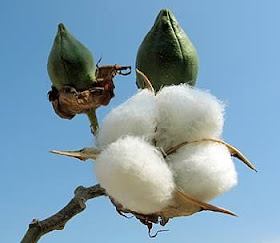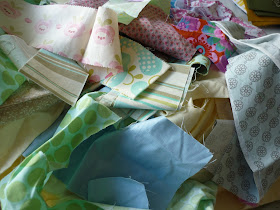The final post in my series on using organic materials is all about organic and environmentally friendly knitting yarns. It's funny that I've left it till last as using organic yarn was my first venture into eco conscious crafting. That was about 6 years ago when I wanted to knit something for someone expecting her first baby, and I found out that she was trying to create as organic and natural an environment for her new little one as possible.
The only yarns I could find then were Rowan Purelife Cotton. This yarn is not only organic, but it is dyed using natural vegetable dyes. The colours were limited and I now believe this yarn has been discontinued.
Once I started looking for more organic yarns I quickly discovered Twilleys Sincere Organic Cotton.
This is a very reasonably priced yarn that knits to standard double knit tension and is available in a good range of colours. It has been around a good while and has stood the test of time. Although readily available in the UK, I'm not sure if it is available elsewhere.
A couple of years ago two new ranges were introduced to the organic market that really are excellent choices.
First there is Debbie Bliss Eco Baby. This yarn is both organic and FairTrade, which means that the farmers who produce it get a fair price for their commodity. It is also dyed with non toxic dyes and the water used for dyeing is recycled.
It sits half way between a 4 ply and a double knit tension, what I believe US knitters call Sports weight. The very nice thing about this yarn is that it is the same tension as Debbie Bliss Baby Cashmerino, so the extensive range of patterns available for that yarn can also be used with this organic one. There are a total of 24 contemporary shades to choose from. What's not to like!
Secondly there are two ranges from Amy Butler. Both by Rowan and called Belle Organic. One range is double knit yarn, the other aran/worsted weight - the colours are identical in both.
This yarn is 50% organic cotton, 50% organic wool, and it is beautiful to work with. It feels ultra soft and so luxurious. The range of colours is not as extensive as the Debbie Bliss range, but still modern and varied. The only possible downside is that it needs to be handwashed, and I some people choose not to use wool for babies incase they are allergic to it.
Having knit with organic cotton yarn and worn organic cotton knitwear, I would never now go back to knitting with traditional cotton. I remember standing with a friend in John Lewis haberdashery department about 18 months ago, helping her choose some yarn for her mother in law to knit some
baby things for her. I picked out a ball of organic cotton and said "feel this" then picked out a traditional produced ball of cotton yarn and said "now feel this". She could instantly feel the difference - feel just how soft that organic ball of yarn was. We soon had quite a few other customers doing exactly the same thing. I should have been on commission from John Lewis that morning - I could have earned a small fortune!
But what about other yarns? Many people don't like knitting with cotton, but they would still like to make environmentally friendly choices.
If you like knitting with wool (and who doesn't?) choose a yarn that is not "superwash". The chemicals that they add to that yarn to make it machine washable are not that good for either the environment or our skin. You may want to choose a yarn comes from sheep that are fairly local to where you live - or at least in the same country. There is no point adding unneccesary air miles and therefore carbon footprint to your yarn, if there is a good choice much closer.
For those of you who live in Britain, you can buy yarns produced in Yorkshire, Somerset and Devon
online here and Rowan also produce a good range of organic British sheep breed yarns under their Purelife label.
There are also some recycled yarns available.
Rowan Purelife Revive is made from used garments that are chosen for their silk, cotton and viscose content. These are then carded to make regenerated fibre, which is then spun into a high quality yarn. Recycling at its best! Rowan also has another range called Purelife Renew, which is 93% recycled wool, 7% polyamide.
Last, but certainly not least, you may wish to consider bamboo yarns.
Bamboo grows and speads very quickly, without the need for pesticides, fertilizer or much water.
It matures and can be replanted within seven years. It helps improve soil conditions and prevents soil erosion at the same time. I have read that converting bamboo to fabric is not at all environmentally friendly, but that it is still compares better than conventional cotton production.
For knitters, one major factor to consider is that bamboo yarn stretches! I personally would not consider using a 100% bamboo yarn. I have however been perfectly happy with bamboo/wool blends.
Perhaps the most widely available of these is Sirdar Snuggly Baby Bamboo. There is now also Sirdar Flirt. Both are standard tension double knitting yarns. I have found that they shed slightly - not enough so that you wouldn't want to use it on a baby and not enough that you would notice it when knitting with a light colour, but if you are knitting with navy and wearing a white T shirt, then you know it sheds.
Baby Bamboo comes on a wide cardboard roll. Boy, do I hate those rolls! They bounce around, roll on the floor and generally misbehave as you knit, and then when you get towards the end of the roll, they suddenly unravel all the remaining yarn in an uneven heap! Kids have great fun playing with those sturdy cardboard rolls when you've finished with them though- it's almost worth buying the yarn just for the "toy" in the middle!
Well, if you're still with me, I'm sorry it's been such a long post. It is by no means comprehensive - just a look at the organic yarns I have first hand experience of.
I would love to hear your thoughts on the subject too!
Till next time..... Julie

























